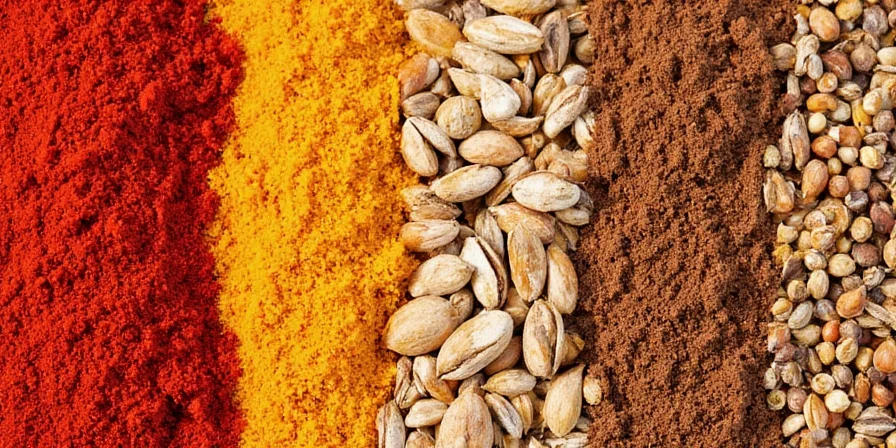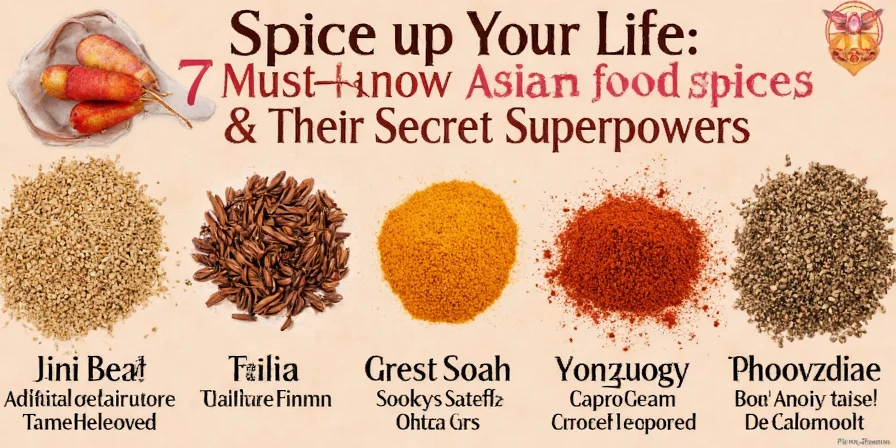Spice Up Your Life: 7 Must-Know Asian Food Spices & Their Secret Superpowers!
Ever taken one bite of a dish and thought, 'Whoa, what just happened in my mouth?' Chances are, it's not just salt or sugar doing the heavy lifting — it’s the magic of spices. In this article, we're taking you on a flavorful journey across Asia to explore the top 7 must-know Asian food spices that can turn your kitchen from bland to brilliant.
Table of Contents
- Sichuan Peppercorn – The Tingling Tongue Twister
- Turmeric – The Golden Healer
- Star Anise – The Licorice Lover's Dream
- Cumin – The Umami Bomb
- Cardamom – The Queen of Aroma
- Fenugreek – The Bitter-Sweet Rebel
- Galangal – The Ginger Look-Alike (But Better)
- Conclusion: Spice Smart, Cook Happy
🌶️ Sichuan Peppercorn – The Tingling Tongue Twister
If you're into spicy food but want something different than regular chili heat, meet your new best friend: Sichuan peppercorn. Despite its name, this isn’t really a pepper — it comes from the citrus family! What makes it special is its ability to cause a tingling, numbing sensation on your tongue, which actually enhances the perception of other flavors.
Pro Tip:
- Toast before grinding to release more aroma.
- Use sparingly — a little goes a long way!
- Perfect for Sichuan hotpot, mapo tofu, and dry-fried dishes.
💛 Turmeric – The Golden Healer
You’ve probably heard about turmeric’s health benefits, but did you know it’s also a staple in many Asian cuisines? Known as “the golden spice,” turmeric adds a warm, slightly bitter flavor and a gorgeous yellow hue to dishes.
| Cuisine | Dish Example | Role of Turmeric |
|---|---|---|
| Indian | Chicken Curry | Base flavor + color |
| Thai | Yellow Curry | Main aromatic paste ingredient |
| Indonesian | Soto Ayam (Chicken Soup) | Color and warmth |
Pro Tip:
- Combine with black pepper and fat to enhance curcumin absorption (your body loves it that way).
- Add early in the cooking process for maximum flavor infusion.
🌿 Star Anise – The Licorice Lover’s Dream
This star-shaped spice is packed with an intense licorice-like flavor. Common in Chinese five-spice blends and Vietnamese pho broths, star anise brings a deep sweetness and complexity to slow-cooked dishes.
Why It’s Special:
- Shine in both savory and sweet dishes.
- Adds depth to braised meats and noodle soups.
- Used in mulled drinks and desserts too!
🔥 Cumin – The Umami Bomb
You might associate cumin with Mexican tacos, but did you know it’s also a powerhouse in Indian and Middle Eastern Asian cuisines? This earthy, nutty spice is a workhorse in spice blends like garam masala and curry powder.
Pro Tip:
- Toasting whole seeds before grinding unlocks a deeper flavor profile.
- Essential in Indian jeera rice, Chinese lamb stir-fries, and Persian stews.
✨ Cardamom – The Queen of Aroma
If there were a royal family of spices, cardamom would be sitting at the head of the table. This expensive spice has a powerful fragrance and complex flavor that ranges from citrusy to minty to floral. Used widely in South Asian and Middle Eastern cuisine, cardamom elevates both savory and sweet dishes.
Did You Know?
- Green cardamom is the most prized variety.
- Crack open the pods and use only the tiny black seeds inside for best results.
- A key ingredient in chai tea and biryani rice.

🥄 Fenugreek – The Bitter-Sweet Rebel
Fenugreek might have a slightly bitter taste, but when used correctly, it can bring a sweet, maple-like undertone to dishes. Common in Indian pickles, dals, and spice blends like panch phoron, fenugreek deserves more credit than it gets.
Pro Tip:
- Roast lightly to reduce bitterness.
- Use in small quantities to avoid overpowering other flavors.
- Popular in South Indian sambar and chutneys.
🧄 Galangal – The Ginger Look-Alike (But Better)
At first glance, galangal looks like ginger, but it’s much harder and has a sharper, piney flavor. Essential in Thai curries and tom kha gai soup, galangal brings a distinct herbal kick that no other spice can replicate.
Pro Tip:
- Peel and slice thinly — don’t grate it like ginger.
- Freeze fresh galangal to extend shelf life.
- Only substitute with ginger in emergencies — flavor is quite different!

Conclusion: Spice Smart, Cook Happy 🌟
The world of Asian food spices is rich, varied, and incredibly rewarding. Whether you're making a fiery Sichuan stir-fry or a soothing Indian dal, the right spices can transform your cooking from ordinary to extraordinary. So go ahead, explore, experiment, and most importantly — enjoy the ride!
Quick Recap: Top 7 Spices & Their Superpowers
| Spice | Flavor Profile | Best For |
|---|---|---|
| Sichuan Peppercorn | Tingling, citrusy numbness | Sichuan dishes, dry-fried meats |
| Turmeric | Earthy, warm, slightly bitter | Curries, yellow sauces, anti-inflammatory boost |
| Star Anise | Licorice-like sweetness | Pho broth, braises, mulled drinks |
| Cumin | Nutty, smoky, earthy | Curries, garam masala, lamb dishes |
| Cardamom | Floral, minty, citrusy | Biryani, chai, desserts |
| Fenugreek | Bitter-sweet, maple-like | Pickles, dals, spice blends |
| Galangal | Sharp, piney, herbal | Thai curries, tom kha gai |
So next time you’re standing in front of that spice rack wondering where to start, remember: every great dish begins with one bold move — opening a jar of spice. Happy cooking!










 浙公网安备
33010002000092号
浙公网安备
33010002000092号 浙B2-20120091-4
浙B2-20120091-4